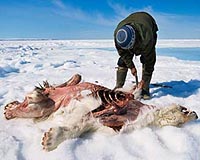| . |  |
. |
Pisa, Italy (SPX) Mar 19, 2010 It might sound like a mashup of monster movies, but palaeontologists have discovered evidence of how an extinct shark attacked its prey, reconstructing a killing that took place four million years ago. Such fossil evidence of behaviour is incredibly rare, but by careful, forensic-style analysis of bite marks on an otherwise well-preserved dolphin skeleton, the research team, based in Pisa, Italy, have reconstructed the events that led to the death of the dolphin, and determined the probably identity of the killer: a 4-meter shark by the name of Cosmopolitodus hastalis. The evidence, published in the latest issue of the journal Palaeontology, comes from the fossilised skeleton of a 2.8 m long dolphin discovered in the Piedmont region of northern Italy. According to Giovanni Bianucci, who led the study: "the skeleton lay unstudied in a museum in Torino for more than a century, but when I examined it, as part of a larger study of fossil dolphins, I noticed the bite marks on the ribs, vertebrae and jaws. Identifying the victim of the attack was the easy part - it's an extinct species of dolphin known as Astadelphis gastaldii- working out the identity of the killer called for some serious detective work, as the only evidence to go on was the bite marks." The overall shape of the bite indicated a shark attack, and Bianucci called in fossil shark expert Walter Landini. "The smoothness of the bite marks on the ribs clearly shows that the teeth of whatever did the biting were not serrated, and that immediately ruled out some possibilities. We simulated bite marks of the potential culprits and, by comparing them with the shape and size of the marks on the fossils, we narrowed it down to Cosmopolitodus hastalis." Circumstantial evidence also supports this verdict: fossil teeth from Cosmopolitodus are common in the rock sequences that the dolphin was found in. " "From the size of the bite, we reckon that this particular shark was about 4 m long" says Landini. Detailed analysis of the bite pattern allowed the researchers to go even further. "The deepest and clearest incisions are on the ribs of the dolphin" says Bianucci, "indicating the shark attached from below, biting into the abdomen. Caught in the powerful bite, the dolphin would have struggled, and the shark probably detached a big amount of flesh by shaking its body from side to side. "The bite would have caused severe damage and intense blood loss, because of the dense network of nerves, blood vessels and vital organs in this area. Then, already dead or in a state of shock, the dolphin rolled onto its back, and the shark bit again, close to the fleshy dorsal fin." The study is significant because of the rarity of such 'fossilized behaviour'. According to Dr Kenshu Shimada, fossil shark expert at DePaul University and the Sternberg Museum of Natural History in the US, "studies like this are important because they give us a glimpse of the ecological interactions between organisms in prehistoric seas. Shark teeth are among the most common vertebrate remains in the fossil record, yet interpreting the details of diet and feeding behaviour of extinct sharks is extremely difficult. Fossil remains of prey species with shark bite marks, like those described by Bianucci and his team, provide direct evidence of what each prehistoric shark ate and how it behaved."
Share This Article With Planet Earth
Related Links DePaul University Darwin Today At TerraDaily.com
 No trade reprieve for polar bears
No trade reprieve for polar bearsDoha (AFP) March 18, 2010 Polar bears, the global mascot in the fight against climate change, were denied a reprieve Thursday when a UN body shot down a US proposal to ban cross-border trade in the animals or their parts. In a vote at the Convention on International Trade in Endangered Species (CITES), meeting in Doha through March 25, the measure fell far short of the required two-thirds majority. The United Sta ... read more |
|
| The content herein, unless otherwise known to be public domain, are Copyright 1995-2010 - SpaceDaily. AFP and UPI Wire Stories are copyright Agence France-Presse and United Press International. ESA Portal Reports are copyright European Space Agency. All NASA sourced material is public domain. Additional copyrights may apply in whole or part to other bona fide parties. Advertising does not imply endorsement,agreement or approval of any opinions, statements or information provided by SpaceDaily on any Web page published or hosted by SpaceDaily. Privacy Statement |